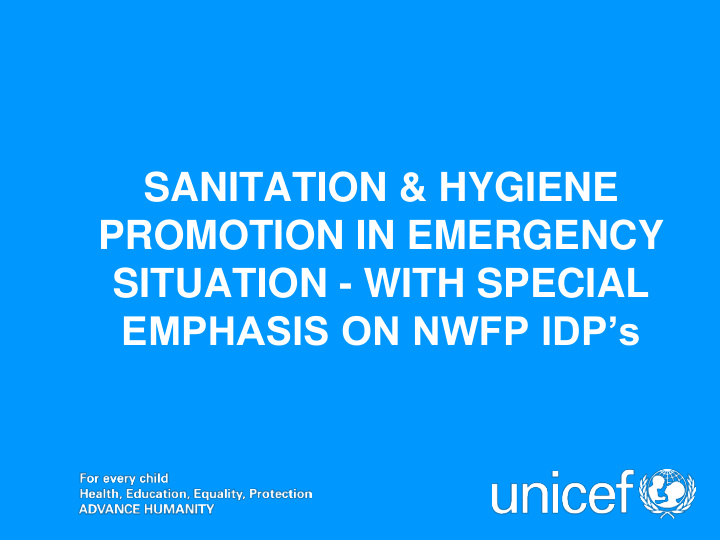



SANITATION & HYGIENE PROMOTION IN EMERGENCY SITUATION - WITH SPECIAL EMPHASIS ON NWFP IDP’s
NWFP IDP EMERGENCY
UNICEF IDPs Relief activities in NWFP, 3
Gender wise Distribution Male, Female, 28960, 51% 28168, 49% UNICEF IDPs Relief activities in NWFP, 4
Age wise distribution > 6 0 y e a r s , 1 2 3 < 5 years, 1 , 2 10810, 19% % 18-59 years, 19964, 35% 5-11 years, 17129, 30% 12-17 years, 7987, 14% UNICEF IDPs Relief activities in NWFP, 5
Breakdown by Age B/w 12 and 17 B/w18 and 59 14 % 41% B/w 5 and 11 27% Above 60 Below 5 2% 16% UNICEF IDPs Relief activities in NWFP, 6
IDP’s in Camps and Off Camps IDP’S IN CAMPS 200,000 IDP’S OFF CAMPS 2,400,000 UNICEF IDPs Relief activities in NWFP, 7
CAMP ESTABLISHMENT UNICEF IDPs Relief activities in NWFP, 8
WATER SANITATION AND HYGIENE (WASH) RESPONSE IN CAMPS
WASH Cluster WASH Cluster is activated since August 2008, initially for the NWFP Flood Emergency response. Later on the IDP Emergency due to Conflict became the major Focus. So far 35 Coordination meetings have taken place in Peshawar. There are more than 45 members in the WASH Cluster. Recently Coordination mechanism has also been activated in Districts Mardan and Swabi. UNICEF IDPs Relief activities in NWFP, 10
WATER SUPPLY • It is being ensured that safe drinking water supply, as per SPHERE guidelines (minimum 15 lpcd), through Tankering (75% IDPs) and tube wells (25%). • Tue Wells/Bore holes construction are under process to minimize Tankering. UNICEF IDPs Relief activities in NWFP, 11
WATER SUPPLY- Response to Emergency UNICEF IDPs Relief activities in NWFP, 12
Water Supply-Response to Emergency UNICEF IDPs Relief activities in NWFP, 13
Water Supply Issues UNICEF IDPs Relief activities in NWFP, 14
Sanitation The means of collecting and disposing of excreta and community liquid wastes in a hygienic way so as not to endanger the health of individuals and the community as a whole (WHO-1987). Areas to be addressed: 1. To provide adequate excreta disposal for displaced people. 2. Promotion of good excreta disposal practices UNICEF IDPs Relief activities in NWFP, 15
Latrine – The first barrier UNICEF IDPs Relief activities in NWFP, 16
Sphere Guidelines Excreta disposal standard 1 : access to, and numbers of, toilets: People have adequate numbers of toilets, sufficiently close to their dwellings, to allow them rapid, safe and acceptable access at all times of the day and night. max. of 20 per toilet. Excreta disposal standard 2 : design, construction and use of toilets: Toilets are sited, designed, constructed and maintained in such a way as to be comfortable, hygienic and safe to use. UNICEF IDPs Relief activities in NWFP, 17
Excreta Control and Disposal: Sanitation Ladder Family Latrines VIP/pour flush Latrines Direct drop Pit Latrines Trench Latrines Controlled Open Defecation Fields Clean-up Programme through volunteers UNICEF IDPs Relief activities in NWFP, 18
How should our latrine design be? 1. Culturally acceptable 2. Affordable 3. Rapid construction 4. Maintainable 5. Easy to clean 6. Safety & protection 7. Fly/mosquito/(odour) control 8. Adapted and suitable for children, older folks, people with HIV Aids UNICEF IDPs Relief activities in NWFP, 19
Sanitation- Response to IDP Emergency. • Sanitation & Hygiene promotion activities (Construction of Pit Toilets, Bathing places, Washing points, Solid Waste Collection points, Health Hygiene promotion sessions, hygiene kits, buckets jerry cans and other NFI’s distribution) as per SPHERE guidelines are being provided. UNICEF IDPs Relief activities in NWFP, 20
Sanitation- Response to Emergencies UNICEF IDPs Relief activities in NWFP, 21
UNICEF IDPs Relief activities in NWFP, 22
Issues 1. Sudden and Huge Influx. 2. Operation & Maintenance. 3. Adaptation to the Camp Environment. 4. Behavior Change. 5. Natural Hazards. UNICEF IDPs Relief activities in NWFP, 23
Field Issues UNICEF IDPs Relief activities in NWFP, 24
Field Issues UNICEF IDPs Relief activities in NWFP, 25
Field Issues: Behavior Change 1. The Overall Sanitation Coverage of NWFP is less than 40 % (People are not used to Toilets!) 2. Since May 1, 2009 influx of IDP’s in Camps have been more than 4000 persons per day. 3. In the present crisis there are some Camps with number of IDP’s more than 50,000. Disease outbreak is very rapid in congested environments. UNICEF IDPs Relief activities in NWFP, 26
Behavior Change UNICEF IDPs Relief activities in NWFP, 27
Results UNICEF IDPs Relief activities in NWFP, 28
Issue. Number of Acute Watery Diarrhea Cases witnessed a sudden increase. Hand Pumps Water was highly contaminated. Ground Water Table was very high. UNICEF IDPs Relief activities in NWFP, 29
Response. 1. Through WHO/PCRWR immediately tested the Hand Pump Water and found to be highly contaminated. 2. Through Government (LGRDD/TMA Mardan) immediately removed the Hand Pumps. 3. Through UNICEF support started WASH interventions (Water Tankering, Chlorination, installation of Solid Waste Collection Mechanism, Health Hygiene Education etc). 4. TMA Mardan took responsibility for installation of Deep Bore Hole and Outside Camp Solid Waste collection and disposal. 5. AWD was controlled within one week. UNICEF IDPs Relief activities in NWFP, 30
Proportion of AWD cases at Sheikh Yaseen IDP Camp, Mardan Proportion of acute diarrhoea at Sheikh Yaseen IDP Camp, Mardan (20-Aug to 12 Oct 2008) 70 62% 60 50 Percentage 41% 42% 35% 34 40 32% 32 32 31 31% 31% 3030 30 30 29 31% 27% 27 26% 26% 26% 26% 25 25 24 24% 30 23 2119 21% 22% 24% 19% 19 23% 20% 20% 19% 18% 19% 21% 17% 16% 25% 15 15% 14 20 13% 12% 11% 8% 10 0 Aug-20 21 22 23 24 25 26 27 28 29 30 31 2 3 4 5 6 7 8 9 10 11 12 13 14 15 16 17 18 19 20 21 22 23 24 25 26 27 28 29 30 1-Oct 2-Oct 3 4 5 6 7 8 9 10 Sept-1 Date UNICEF IDPs Relief activities in NWFP, 31
Long Live Pakistan UNICEF IDPs Relief activities in NWFP, 32
Recommend
More recommend